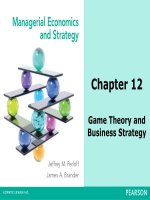Managerial economics strategy by m perloff and brander chapter 7 organization and market structure
Bạn đang xem bản rút gọn của tài liệu. Xem và tải ngay bản đầy đủ của tài liệu tại đây (519.6 KB, 35 trang )
Chapter 7
Firm Organization
and
Market Structure
Table of Contents
•
7.1 Ownership & Governance of Firms
•
7.2 Profit Maximization
•
7.3 Owner’s vs. Manager’s Objectives
•
7.4 The Make or Buy Decision
•
7.5 Market Structure
7-2
© 2014 Pearson Education, Inc. All rights reserved.
Introduction
• Managerial Problem
–
–
Many managers who receive an annual bonus based on the firm’s performance this year
may take actions that increase the firm’s profit this year but reduce profits in future years.
Does evaluating a manager’s performance over a longer time period lead to better
management?
• Solution Approach
–
Owners have to decide what objectives the firm should pursue, and they need to structure
incentives to induce managers to pursue these objectives. In addition, managers need to
decide which stages of production the firm should perform and which to leave to others.
• Empirical Methods
–
–
–
7-3
Ownership and governance of firms affect the firm’s objectives.
The owner-manager relationship is one of principal-agent relationship where the principal
delegates tasks to an agent. This delegation creates a transaction cost called an agency
cost and many features of the firm’s organization try to minimize it.
In the pursuit of their main goal, such as maximizing profit, owners and managers must
make decisions about the nature of the firm, such as the make or buy decision. Market
structures affect such a decision.
© 2014 Pearson Education, Inc. All rights reserved.
7.1 Ownership & Governance of
Firms
• Private, Pubic and Non-Profit: The Private Sector
–
–
Consists of firms that are owned by individuals or other non-governmental entities
and whose owners may earn a profit
Examples are Apple, Heinz, and Toyota. In almost every country, this sector provides
most of that country’s gross domestic product (75% of GDPUSA).
• Private, Pubic and Non-Profit: The Public Sector
–
–
Consists of firms and other organizations that are owned by governments or
government agencies, called state-owned enterprises
Examples are the armed forces, the court system, most schools, colleges,
universities, and Amtrak. This sector may be small or large (12% of GDP USA).
• Private, Pubic and Non-Profit:The Non-Profit Sector
–
–
7-4
Consists of organizations that are neither government-owned nor intended to earn a
profit, but typically pursue social or public interest objectives (non-government, notfor-profit sector)
Examples include Greenpeace, Alcoholics Anonymous, the Salvation Army, and other
charitable, educational, health, and religious organizations.
© 2014 Pearson Education, Inc. All rights reserved.
7.1 Ownership & Governance of
Firms
• Ownership of For-Profit Firms: Sole Proprietorships
– Firms owned and controlled by a single individual
• Ownership of For-Profit Firms: Partnerships
– Businesses jointly owned and controlled by two or more people operating
under a partnership agreement.
• Ownership of For-Profit Firms: Corporations
– Firms owned by shareholders, who own the firm’s shares or stocks.
– Each share is a unit of ownership in the firm. Therefore, shareholders own
the firm in proportion to the number of shares they hold.
– Shareholders elect a board of directors to represent them. In turn, the
board of directors usually hires managers who manage the firm’s
operations.
– The legal name of a corporation often includes the term Incorporated (Inc.)
or Limited (Ltd) to indicate its corporate status.
7-5
© 2014 Pearson Education, Inc. All rights reserved.
7.1 Ownership & Governance of
Firms
• Publicly Traded Corporation
–
–
Corporations whose shares can be readily bought and sold by the general public
Stocks may be available at the New York Stock Exchange, the NASDAQ, the Tokyo
Stock Exchange, the Toronto Stock Exchange, or the London Stock Exchange.
• Closely Held Corporation
–
–
Shares not available for purchase or sale on an organized exchange.
Typically its stock is owned by a small group of individuals (private equity).
• From Publicly Traded to Closely Held Corporation
–
–
–
7-6
To make the transition the closely held firm makes an initial public offering (IPO) of
its shares on an organized stock exchange.
One major advantage of going public is to raise money. However, a major
disadvantage is that ownership of the firm becomes broadly distributed, possibly
causing the original owners to lose control of the firm.
It is also possible for a publicly traded firm to go private and convert to closely held
status. Examples are Toys-R-Us and Burger King
© 2014 Pearson Education, Inc. All rights reserved.
7.1 Ownership & Governance of
Firms
• Liability and Ownership
– Owners of a corporation are not personally liable for the firm’s debts; they
have limited liability: The personal assets of the corporate owners cannot
be taken to pay a corporation’s debts even if it goes into bankruptcy.
– Traditionally, the owners of sole proprietorships and partnerships were
fully liable, individually and collectively, for any debts of the firm. Now
they can be a limited liability company (LLC). The precise regulations that
apply to LLCs vary from country to country and from state to state within
the United States.
• Firm Size and Ownership
– Most large firms are corporations. According to the U.S. Statistical Abstract
2012, U.S. corporations are only 18% of all nonfarm firms but make 81% of
sales revenue and 58% of net income. Nonfarm sole proprietorships are
72% of firms but make only 4% of the sales revenue and earn 15% of net
income.
– Corporations that earn over $50 million are less than 1% of all
corporations, but they make 77% of revenue.
7-7
© 2014 Pearson Education, Inc. All rights reserved.
7.1 Ownership & Governance of
Firms
• Firm Governance: Small Firms
– In a small private sector firm with a single owner-manager,
the governance of the firm is straightforward: the ownermanager makes the important decisions for the firm.
• Firm Governance: Publicly Traded Corporation
– The shareholders own the corporation. However, most of
them play no meaningful role in day-to-day decisionmaking or even in long range planning.
– Shareholders elect a board of directors and delegate many
of their ownership rights to them.
– The board of a large publicly traded corporation normally
includes outside directors and inside directors, such as the
chief executive officer (CEO) of the corporation and other
senior executives.
7-8
© 2014 Pearson Education, Inc. All rights reserved.
7.2 Profit Maximization
• Revenue (R) is price times quantity.
• Cost(C), the correct measure is the opportunity cost: the value of the best alternative
use of any input the firm employs. The full opportunity cost of inputs used might
exceed the explicit or out-of-pocket costs recorded in financial accounting
statements.
• Profit (π) is Revenue minus Cost. If π < 0, the firm makes a loss.
• To add profits over time calculate the present value, in which future profits are
discounted using the interest rate.
7-9
© 2014 Pearson Education, Inc. All rights reserved.
7.2 Profit Maximization
• Two Steps to Maximize Profit: π (q) = R (q) – C (q)
– Profit varies with the level of output because both revenue
and cost vary with output.
– There are two key decisions to maximize profit.
• First Step: Output Decision
– What is the output level, q, that maximizes profit or
minimizes loss?
• Second Step: Shutdown Decision
– Is it more profitable to produce q or to shut down and
produce no output?
7-10
© 2014 Pearson Education, Inc. All rights reserved.
7.2 Profit Maximization
• Rule 1: Set output where profit is maximized
– If the firm knows its entire profit curve (Figure 7.1), it sets output at q*to
get π*.
• Rule 2: Set output where Mπ = 0
– Marginal profit , ∆p/∆q, where ∆q = 1, is the slope of the profit curve. The
maximum profit occurs where the slope is zero.
• Rule 3: Set output where MR(q)=MC(q)
– Marginal Profit = MR - MC. The extra income raises profit but the extra cost
reduces profit. Maximum profit occurs at MR(q) = MC(q).
– Using calculus: dπ (q)/dq = dR (q)/dq – dC (q)/dq = 0; MR(q)=MC(q)
7-11
© 2014 Pearson Education, Inc. All rights reserved.
7.2 Profit Maximization
Figure 7.1 Maximizing Profit
7-12
© 2014 Pearson Education, Inc. All rights reserved.
7.2 Profit Maximization
• Shutdown Rules
– Should the firm shut down if its profit is negative? It
depends
• Shutdown Rule 1: Shut down only if loss is reduced
– This rule applies to the short run and long run alike.
• Shutdown Rule 2: Shut down only if revenue < avoidable cost
– In the short run, variable costs are avoidable but fixed
costs are unavoidable (sunk costs).
– As long as revenue covers variable costs and some fixed
costs, no shut down occurs.
– In the long run all costs are avoidable; shutting down
eliminates all costs.
7-13
© 2014 Pearson Education, Inc. All rights reserved.
7.2 Profit Maximization
• Profit Over Time
– Firms maximize profit not only for the current period. They are
normally interested in maximizing profit over many periods.
– The difference between maximizing the current period’s profit and
long-run profit is important in some situations.
• Present Value: PV = FV / (1+i)t
– Compound Interest Rate: $100 today (PV) at a 10% interest rate
has a future value (FV) of $110 in one year, and $121 in two
years. In general FV = PV (1+i)t, where t is the number of years.
– Money in the future is worth less than money today: $100 in one
year is less than $100 today. In general, PV = FV / (1+i)t
– Shareholders of a firm may value a stream of profits over time by
calculating the present value, in which future profits are
discounted using the interest rate (see Appendix 7 for more
detail).
7-14
© 2014 Pearson Education, Inc. All rights reserved.
7.3 Owners’ vs. Managers’
Objectives
• Consistent Objectives: Principal-Agent Problem
– Owners (principal) delegate tasks to managers and other workers
(agent) in most firms.
– If the principal wants to maximize profit and agents want to
maximize their own incomes or perks the resulting profit is not
the maximum (agency cost).
• Consistent Objectives: Contingent Rewards
– To make the owner and manager objectives more closely aligned,
many firms use contingent rewards: higher pay if the firm does
well.
– A year-end bonus based on the performance of the firm or a group
of workers within the firm
– A stock option or the right to buy a certain number of the firm’s
shares at a pre-specified exercise price within a specified time
7-15
© 2014 Pearson Education, Inc. All rights reserved.
7.3 Owners’ vs. Managers’
Objectives
• Consistent Objectives: Profit Sharing
– If profit is easily observed and the owner and manager want to
maximize their own earnings, pay the manager a share of the
firm’s profit.
• Graph Application
– In Figure 7.2, the manager (agent) earns 1/3 of the joint profit,
shareholders (principals) get 2/3. The output level, q*, maximizes
both shares. No conflict.
– By 2005 over 70% of firms provided annual stock options to their
top three executives, compared to virtually none in 1950 and
about 50% in 1970.
– 75% of total compensation of a chief executive at S&P 500 firms
came from incentives in 2009.
7-16
© 2014 Pearson Education, Inc. All rights reserved.
7.3 Owners’ vs. Managers’
Objectives
Figure 7.2 Profit Sharing
7-17
© 2014 Pearson Education, Inc. All rights reserved.
7.3 Owners’ vs. Managers’
Objectives
• Conflictive Objectives: Revenue Objectives
– Sometimes profit can be manipulated by owners or managers. So profit
sharing is not possible.
– Revenue sharing: executive compensation is primarily determined by the
firm’s revenue. But, managers prefer to maximize revenue rather than
profit.
• Graph Application
– In Figure 7.3, the manager is paid a share of revenue. It is best for the
manager to set output at q = 5, where revenue is 25 and profit just 5. The
output that maximizes profit, q = 3, where profit is 9 and revenue is 21, is
not chosen.
7-18
© 2014 Pearson Education, Inc. All rights reserved.
7.3 Owners’ vs. Managers’
Objectives
Figure 7.3 Revenue Maximization
7-19
© 2014 Pearson Education, Inc. All rights reserved.
7.3 Owners’ vs. Managers’
Objectives
• Conflicting Objectives: Personal Effort and Earnings
– A manager who receives a fixed salary or a compensation not tied to
performance and who values leisure may not work hard to maximize
profit.
– If a board insists on a profit target, a manager may only satisfice it.
• Conflicting Objectives: Social Objectives
– Corporations often make large contributions to hospitals, universities,
environmental projects, disadvantaged groups, or other causes. Are these
managers pursuing social policy with shareholders’ money?
• Conflicting Objectives: Perks
– Some perks save a manager’s time and increase productivity. However,
some managers unilaterally grant themselves perks with little or no
tangible advantage to the firm. If the firm reduces the manager’s salary by
the cost of such benefits, then these benefits do not harm the firm’s
bottom line.
7-20
© 2014 Pearson Education, Inc. All rights reserved.
7.3 Owners’ vs. Managers’
Objectives
• Monitoring & Controlling Manager’s Actions: Direct Monitoring
– If the owner and manager work side by side, monitoring the
manager is easy.
– However, most of the time the owner cannot observe the actions of
the manager; profit is subject to uncertainty; and parties cannot
write an enforceable contract.
• Monitoring & Controlling Manager’s Actions: Indirect Monitoring
– Board and Managers: Senior executives are restricted in their ability
to carry out activities outside the firm (disclosure conflict of interest)
– Shareholders and Board: rules may require to have outside directors;
nature and frequency of elections. But, difficult to specify or legally
enforce what constitutes appropriate effort for board members.
– Say-on-Pay (SOP), the Dodd–Frank Wall Street Reform, and
Consumer Protection Act of 2010: shareholders vote periodically on
compensation going to senior executives.
7-21
© 2014 Pearson Education, Inc. All rights reserved.
7.3 Owners’ vs. Managers’
Objectives
• Takeovers & the Market for Corporate Control
– Managers can be disciplined through the market for
corporate control: outside investors buy enough shares to
take over control of an under-performing publicly traded
firm.
• Poison Pill Defense
– Firms can defend with a shareholder rights plan (poison
pill) in the United States.
– Poison pills may not prevent a takeover, but usually
benefits the original managers or board of directors to
induce them not to further fight the takeover.
7-22
© 2014 Pearson Education, Inc. All rights reserved.
7.4 The Make or Buy Decision
• Horizontal and Vertical Dimensions
– Managers make decisions that affect the structure of the firm in
two dimensions
– Horizontal dimension: size of the firm in its primary market
– Vertical dimension: stages of the production process in which the
firm participates
• Supply Chain Management
– To produce and sell a good involves many sequential stages of
production, marketing, and distribution activities.
– A manager decides how many stages the firm will undertake itself
– Also, at each stage, whether to carry out the activity within the
firm or to pay for it to be done by others.
7-23
© 2014 Pearson Education, Inc. All rights reserved.
7.4 The Make or Buy Decision
• Stages of Production
– Figure 7.4 illustrates the sequential
or vertical stages of a relatively
simple production process (such as
bread).
– At the top of the figure, in the
upstream, firms use raw inputs
(such as wheat) to produce semiprocessed materials (such as flour).
– Then, in the downstream, the same
or other firms use the semiprocessed materials and labor to
produce the final good (such as
bread), q = f(M, L).
– In the last stage, the final
consumers buy the product.
7-24
© 2014 Pearson Education, Inc. All rights reserved.
Figure 7.4 Vertical
Organization
7.4 The Make or Buy Decision
• Vertical Integration
– A firm that participates in more than one successive stage
of the production or distribution of goods or services is
vertically integrated.
– A firm may vertically integrate backward and produce its
own inputs, or forward and buy its former customer.
– A firm can be partially vertically integrated. It may produce
a good but rely on others to market it. Or it may produce
some inputs itself and buy others from the market.
– Some firms buy from a small number of suppliers or sell
through a small number of distributors. These firms often
control the actions of the firms with whom they deal by
writing contractual vertical restraints that create quasivertical integration (franchisor and franchisee).
7-25
© 2014 Pearson Education, Inc. All rights reserved.









